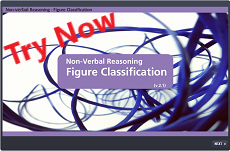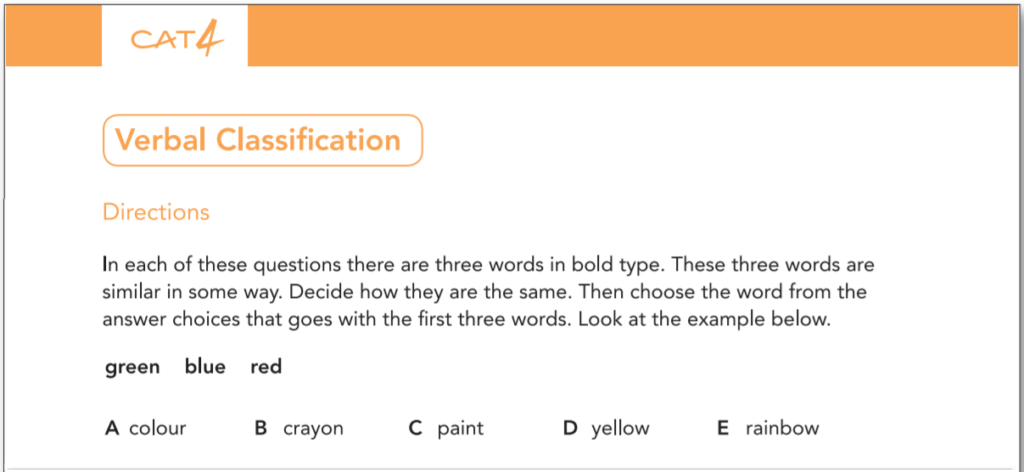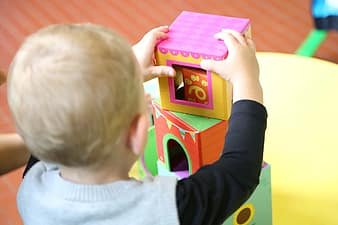The non-verbal figure classification test is one of the 8 sub-tests that make up the battery of CAT4 assessments. The sub-test checks your child’s non-verbal figure classification skills which involves the ability to understand, analyse, and recognize visual information and patterns.
Non-verbal figure classification is an essential part of understanding information and non-verbal cues. It allows an individual to categorise and interpret information through the identification of groups, patterns, and common traits. Understanding non-verbal cues when communicating face-to-face is pivotal to develop interpersonal connections, successful business interactions, and facilitate clear and unambiguous communication. You can try the free version of this subtest by clicking the image below – this has been taken from the Basic CAT4 Package which does not include tracking or analysis – the Ultimate version provides a CAT4 Test History and CAT4 Test Analysis:
Figure classification is a foundational cognitive ability assessed in the CAT4 test. This component of the non-verbal reasoning section evaluates a student’s ability to analyze and categorize visual information based on shared characteristics or relationships, such as shapes, patterns, and diagrams. By improving this skill you not only improve your CAT4 test score but also enhances your ability to think and increase your cognitive skills in areas like problem-solving, spatial reasoning, and logical thinking. These are essential skills for academic success, particularly in STEM subjects like mathematics, physics, and engineering, where visual data interpretation is crucial.
For students preparing for the CAT4 test, practicing figure classification will boost confidence and performance, while also build a foundation for critical thinking and adaptability. This will prepare the student for success in their future academic life and professional career.
Real World Application of Non-Verbal Figure Classification Skills
Outside of the classroom in the real world, figure classification is used all the time from analysing and classifying visual data like graphs and charts to enable better decision-making. In technology figure classification is used by image recognition and artificial intelligence to provide advanced models. In healthcare, it is required in order to interpret medical scans, such as X-rays and MRIs. Even in everyday life it helps to improve tasks like organizing spaces, reading maps, or solving puzzles.
Non verbal figure classification has significant real-world applications and is essential in fields that require visual-spatial skills, such as architecture, healthcare, engineering, graphic design, and technology. Interpreting diagrams, blueprints, x-rays, or complex visual data is crucial in these areas. This ability also supports problem-solving in everyday tasks, such as assembling furniture, reading maps, or navigating new environments.
In professions like medicine, non-verbal reasoning and classifications aids in understanding and grouping medical imaging, such as X-rays or MRIs helping doctors to identify tumours and other such anomolies. By helping enable individuals to recognize patterns, analyze relationships, and draw logical conclusions without relying on verbal cues it provides a foundation for problem solving. Creative industries, where visualizing concepts and designing innovative solutions benefit hugely for an individual’s ability to understand non-verbal concepts. Its a vital skills to help individuals approach challenges with a structured analytical mindset, and is very important in our understanding and classifying everyday non-verbal communication cues such as:
Facial Expressions: The human countenance serves as a reservoir of non-verbal indicators. Smiles, furrowed brows, raised eyebrows, or a downward curve of the mouth, all convey a spectrum of emotions. Proficiently recognizing these expressions empowers you to gauge the emotional disposition of the person you are engaging with and adapt your responses accordingly.
Body Language: The manner in which an individual carries themselves communicates a wealth of information, including confidence, nervousness, or indifference. For instance, an erect posture with shoulders squared exudes self-assuredness, while slumped shoulders can signify diminished confidence.
Gestures: The movements of one’s hands, be it pointing, waving, or offering a thumbs-up, are potent non-verbal signals conveying intentions and reactions devoid of linguistic expression. Proficiency in comprehending these gestures helps avert misunderstandings and enhances the clarity of communication.
Eye Contact: The eyes have long been regarded as the mirror to the soul, as they offer deep insight into one’s engagement and emotional state. The continuity or avoidance of eye contact can indicate levels of interest, discomfort, or even potential duplicity.
Tone of Voice: The tonal quality, pitch, and cadence of speech are replete with non-verbal nuances. For example, a rapid, high-pitched tone can convey enthusiasm, whereas a measured, lower-pitched voice may signify solemnity or sadness.
Proximity: The physical distance maintained during an interaction can signify the degree of comfort and intimacy between individuals. Recognizing the subtleties of personal space boundaries is pivotal in ensuring respectful and effective communication.
Cultural Divergence: It’s worth noting that non-verbal cues can diverge significantly across cultural contexts. What may be deemed an appropriate level of eye contact, specific gestures, or facial expressions in one culture could be entirely distinct in another. Acknowledging these cultural distinctions is essential for proficient cross-cultural communication.
Deception Detection: Proficiency in non-verbal classification is also instrumental in detecting potential deception. Micro expressions, discreet changes in body language, and inconsistencies in vocal modulation often serve as telltale signs of untruthfulness.
Emotional Intelligence: Cultivating emotional intelligence, which encompasses the ability to recognize and interpret non-verbal cues, is integral for personal and professional advancement. It equips individuals to respond empathetically to the emotional cues of others, foster trust, and establish more profound and enduring connections.
Practical Utility
In a spectrum of domains, ranging from psychology to sales, negotiation, and leadership, adeptness in decoding non-verbal communication constitutes a potent asset. It enables individuals to customize their approach in accordance with the emotions and needs of those they engage with.
In summary, non-verbal classification is a skill that substantially elevates one’s capacity to understand information and communicate effectively. By discerning and interpreting non-verbal cues, individuals gain profound insights into the emotional states, intentions, and attitudes of their counterparts. Whether in personal or professional interactions, this skill proves indispensable for establishing rapport, defusing conflicts, and forging meaningful connections. Refining and honing one’s ability to classify non-verbal cues remains a valuable asset in our interconnected world.
Explanations on the other sub-tests that make up the CAT4 assessment can be accessed below:
- Non-Verbal Figure Classification
- Non-Verbal Figure Analysis
- Non-Verbal Figure Matrices
- Non-Verbal Figure Recognition
- Numerical Analogies
- Numerical Series
- Verbal Analogies
- Verbal Classification
If you haven’t already, read my story by clicking here on how I helped my son pass with flying colours.






